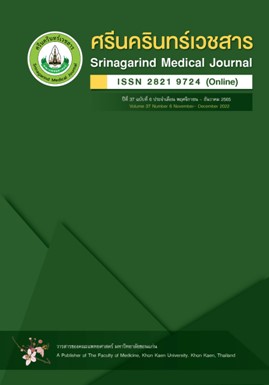ความถูกต้องของคู่มือการสอนสวนปัสสาวะด้วยตนเองแบบสะอาดในผู้ป่วยกระเพาะปัสสาวะพิการ
The Validity of Clean Self-Intermittent Catheterization Instruction Manual for Neurogenic Bladder Patient
Abstract
หลักการและวัตถุประสงค์: การสอนสวนปัสสาวะด้วยตนเองแบบสะอาด วิธีปฏิบัติไม่เป็นไปในแนวทางเดียวกัน ขึ้นกับประสบการณ์แต่ละบุคคล จึงได้ศึกษาความถูกต้องของคู่มือการสอนสวนปัสสาวะด้วยตนเองแบบสะอาด เพื่อใช้เป็นแนวทางการสอนผู้ป่วยในโรงพยาบาลให้เกิดมาตรฐานเดียวกัน
วิธีการศึกษา: ศึกษาความถูกต้องของเนื้อหา ความเหมาะสมทางภาษา และสื่อวิดีทัศน์ของคู่มือ โดยผู้เชี่ยวชาญ ด้วยการวิเคราะห์ดัชนีสอดคล้อง (Index of item objective congruence: IOC) ข้อมูลที่ IOC ≥ 0.8 คือ ข้อมูลมีความสอดคล้องกับวัตถุประสงค์ คู่มือจะถูกแก้ไขและวิเคราะห์จน IOC ≥ 0.8 และประเมินความพึงพอใจต่อคู่มือสำหรับพยาบาล
ผลการศึกษา: การศึกษาความถูกต้องจากผู้เชี่ยวชาญ 3 ราย พบว่าความถูกต้องของคู่มือ ในหัวข้อคำแนะนำ วิธีประเมิน และการสวนปัสสาวะเพศชายมีค่า IOC = 0.33, 0.33 และ 0.66 ตามลำดับ การศึกษาความถูกต้องของสื่อวีดีทัศน์ พบว่า หัวข้อความรู้ การปฏิบัติ การสวนปัสสาวะเพศหญิงมีค่า IOC = 0.66 ปรับปรุงทุกหัวข้อให้ IOC ≥ 0.8 เมื่อเปรียบเทียบความรู้ก่อนและหลังอ่านคู่มือ ค่าเฉลี่ยความรู้ของพยาบาลก่อนอ่านคู่มือสำหรับพยาบาลวิชาชีพที่จบเฉพาะทางด้านการฟื้นฟู จำนวน 30 ราย เท่ากับ 15.43 คะแนน ค่าเฉลี่ยความรู้หลังอ่านคู่มือ เท่ากับ 17.17 คะแนน ดังนั้นพยาบาลมีความรู้เพิ่มมากขึ้นอย่างมีนัยสำคัญทางสถิติ (p ≤ 0.25) เท่ากับ 0.016 แตกต่างมากที่ 1.733
สรุป: คู่มือการสอนสวนปัสสาวะด้วยตนเองแบบสะอาดในผู้ป่วยกระเพาะปัสสาวะพิการ มีความถูกต้องของเนื้อหา ความเหมาะสมทางภาษา และสื่อวิดีทัศน์ พยาบาลมีความพอใจต่อคู่มือระดับมากและมีคะแนนความรู้เพิ่มขึ้นหลังอ่านคู่มือ
คำสำคัญ: การสวนปัสสาวะด้วยตนเอง, คู่มือการสวนปัสสาวะด้วยตนเอง, กระเพาะปัสสาวะพิการ
Background and objective: Methods of practice for teaching self-cleaning urinary catheterization do not all follow in the same direction. The methods of practice depend on the experience of each person. This study examined the accuracy of the manual for teaching clean urinary catheterization in patients with impaired bladder. To serve as a model for training hospital patients to adhere to the same standard.
Methods: Examine the quality of a manual accuracy, the language and audiovisual material appropriateness. By analyzing the Index of item objective congruence (IOC), the data at IOC ≥0.8 means that the data is consistent with the objective. Manuals are modified and studied till IOC ≥ 0.8. The rehabilitation nurse satisfaction survey is used to evaluate the handbook after it has been used.
Results: The validity that evaluated by three professionals, the IOC of the correctness of manual, in the section of recommendation for patient, evaluation method, and demonstration of clean urinary catheterization for male were equal to 0.33, 0.33 and 0.66, respectively. For determining the precision of the video, the IOC in the topic of knowledge of neurogenic bladder, procedure, and demonstration of clean urinary catheterization for female were equal to 0.66. After correcting, the IOC for each part was ≥0.8. According to independent surveys was evaluated by 30 rehabilitation nurses, compared the knowledge before studied the manual, the average score was 15.43 and after studied the manual, the average score was 17.17. Therefore, the rehabilitation nurses had statistically significant (p≤0.25) increase in knowledge equal to 0.016 difference in 1.733
Conclusion: Clean Self-Intermittent catheterization instruction manual for Neurogenic bladder patient, the appropriate handbook, the proper language, and audiovisual material were available to the patients. Both the satisfaction survey and the knowledge of rehabilitation nurses increased.
Keywords: self-intermittent catheterization, self-intermittent catheterization instruction manual, neurogenic bladder


